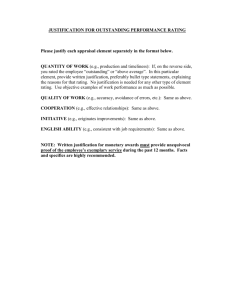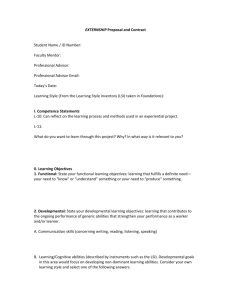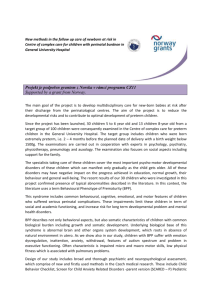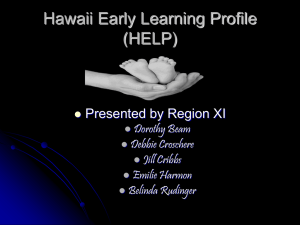purpose of playgroup
advertisement
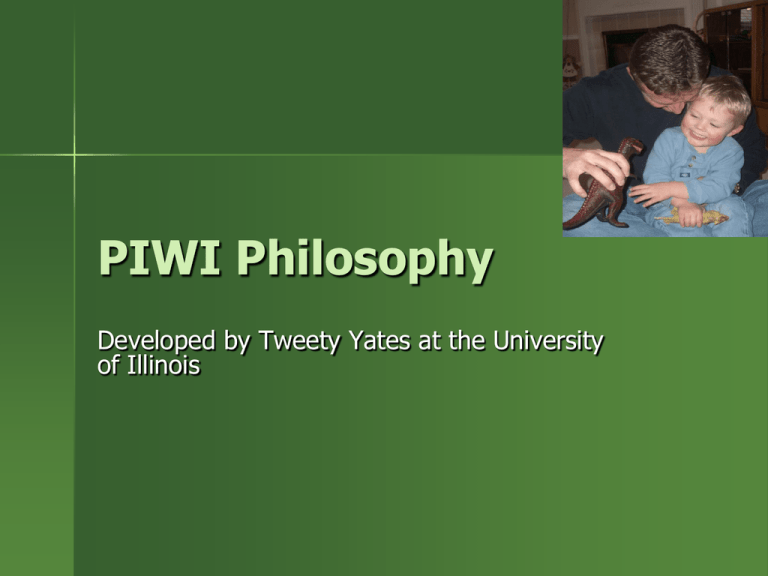
PIWI Philosophy Developed by Tweety Yates at the University of Illinois PIWI = Parents Interacting with Infants Competence Confidence Mutual Enjoyment Competence Children have opportunities to demonstrate competence and to expand on it while exploring the environment, interacting with others, and meeting IFSP goals. Parents demonstrate their skills as a parent and expand on them while observing their child’s competence. Confidence Both parent and child should have confidence in themselves and their abilities; they should have many opportunities to become aware of their abilities and feel good about what they’re doing. Mutual Enjoyment Parent and child should feel secure and enjoy being together in the setting. Parents should gain ideas of how to transport these enjoyable activities to home and the community. Individualizing Individual goals identified by parents and embedded within the environment and interactions…includes IFSP goals. Facilitator Team 2 or more facilitators, often from different disciplines, who interact with one another as they plan, execute and debrief a play group. Triadic Relationship 3 people interacting in a way to enhance the learning, competence, confidence and mutual enjoyment of the interaction. Dyadic Relationship 2 people interacting – this should be the parent and child in the play group, not the facilitator and the child. Developmental Topic Every play group is organized around a developmental topic selected to highlight the children’s developmental competencies and interests and move towards meeting the child/parent goals on the IFSP. Why is Interaction Important? What is the child learning from this interaction? What is the adult learning from this interaction? What are the dyad partners learning about each other from this interaction? What is being learned? Feelings about self Expectations for others Expectations for self Motivation to learn and explore All aspects of development are affected: Emotional Social Cognitive Communicative Motor The emotional experience of self as COMPETENT AND LOVED underlies all. Disabilities or a developmental delay can result in these interactive blocks: Ability to self-regulate Responsiveness Initiation of interaction Predictability Exploratory and developmental competence Why emphasize parentchild interaction in EI? Critical for healthy relationships Certain characteristics of interaction appear to support better developmental outcomes Interpersonal interaction is a spontaneous, natural process that results from natural tendencies of both partners Some individual differences in child (disability) or in parent (stress) may present unique challenges to the interactive partner Successful parent-child interaction promotes child development, mutual pleasure, and a sense of competence in both partners DYADIC CHARACTERISTICS/ STRATEGIES: WHAT THE ADULT CAN DO Set the stage for interaction Position self and child so that mutual gaze and joint action are possible Provide objects and events appropriate to the child’s development and understanding Physically support the child if needed to obtain freedom to interact with others and with objects Maintain child’s interest and attention: Establish yourself as an interesting partner Maintain a warm, encouraging manner Provide clear emotional cues Use novelty and exaggeration to capture interest Be sensitive and responsive to the child’s emotional expression Regulate the pace of the interaction in response to the child’s mood and emotional cues Recruit the child’s attention when unengaged or unfocused Introduce new focus or activity when needed Establish reciprocal roles Respond to child’s initiations Establish predictable, reciprocal interaction routines Provide time for the child to take a turn Let the child know that a response is expected…then wait Imitate…then wait (imitation game) Match and Follow Observe, interpret, and join the child’s focus of attention and interests Maintain the topic of child’s initiations Comment on the child’s activities and interests Support developmentally more challenging participation Elaborate on the child’s communicative attempts Add new actions and elements to established interaction routines Balance support (suggestion, demonstration) with expectations/opportunities for independence Pose “dilemmas” for the child to solve Goals of a Dyadic Interaction Provide pleasure through interaction for both partners Promote self-efficacy and self-esteem in both partners Provide experiences that promote optimal development and learning in the child Affirm and strengthen the parent-child relationship Kids on the Move Classes PIWI- Expanding (older) PIWI- Let’s Play (younger) Structured Feeding Motor Behavior Articulation --These are all PIWI classes, some are just specialized PIWI classes. Natural Environment “Natural Environments” means settings that are natural or normal for the child’s age peers who have no disabilities. When to Refer a Child to Classes After several months of visiting a child/family When services can’t be met in the child’s natural environment Several months of not making developmental progress Justification Statement Justification statement is only needed for services which are provided to the CHILD and which are not provided in the natural environment No Justification statement is needed for services to PARENTS Reasonable justification statement: Links to concerns Links to outcomes The service can actually address the reason stated in the justification The IFSP must include “a justification of the extent, if any, to which the services will not be provided in a natural environment”. A justification statement may be reflective of the family’s concerns and priorities, or a determination that the natural environment are not conducive to achievement of the child and family outcomes. Examples of Justification Katie is an only child and has few children her age in her neighborhood. Class provides an opportunity for her to socialize and receive peer modeling. Brian is one of triplets and parents are struggling to find time in the day to give him one-on-one time. Class provides a structured time each week to spend time with Brian. Kim is not making developmental progress after 6 months of services in the home. Class will provide a more structured learning environment to address goals. How PIWI is applied at KOTM Most classes run for 1 ½ hours; typically from 9:30-11:00 or 11:301:00 Tues –Friday one time a week for each individual class. Structured classes run 2 times a week for each individual class PIWI Schedule (sample) Free time (9:30-10:00) Motor room (10:00-10:20) Snack time (10:20-10:35) Books (10:35-10:40) Music Time (10:40-11:00) Structured PIWI Schedule Motor room (11:30-12:00) Transition Activity (12:00-12:05) Learning Box (12:05-12:25) Snack (12:30-12:45) Structured/Social Activity (12:4512:55) Music (12:55-1:00) Music and Book Activities Integrate social, cognitive, communicative, and physical development Self-confidence/mastery of routine and repetition Interactions with People Joy!! Free Play Promote social interactions between the children and other adults through play Follow the child’s lead in play Model and expand communication in a conversational, fun way Build play and fine motor skills Motor Activity Promote social awareness of body and space Strengthening muscles Improving balance and coordination Using communication and social skills Encourages social interaction, turn taking Snack Time Promote self-feeding, fine motor skills—We LOVE messes!!! Promote self-help skills, i.e. washing hands, clean-up Promote social skills Promote communication by requesting, pointing, naming, commenting, choosing Sibling Care Offered by the EEC For children 2mo. Through the first day of 1st grade (6 yrs) Three Rooms: 1. 2 month-1 year olds (Jane) 2. 1-2 year olds (Ruth/Lacy) 3. 3 year olds and over (LaRayne/Lia) Sibling Care Limited space available due to licensing teacher to child ratio requirements 1:4 Ratio in baby class (4 slots for sibs) 1:6 Ratio in Toddler class (5 slots for sibs) 1:17 Ratio in Over 3 class (10 slots for sibs) Each child needs a child registration filled out plus a copy of their immunizations Sib Care Sign Ups LaRayne adds sibs to the list & all sib sign ups must go through her for day classes. Evening childcare sign up is with KOTM receptionist Sib List available to view on the network: (Ei-ecc/playgroups/asibcarelist/currentsibcarelist) Some kids are put on “overbooked” and some on the “waiting list” LaRayne moves kids up as appropriate

